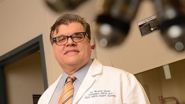(Press-News.org) Polycystic ovary syndrome, a condition affecting about 10 percent of women and characterized by excess male hormone and increased risk of diabetes and heart disease, appears to cause a sort of double jeopardy for those struggling the hardest to control blood sugar levels, researchers report.
Humans use insulin and other non-insulin mechanisms to convert blood sugar, or glucose, into energy and control levels in the blood, where it becomes a destructive force.
A new study in the Journal of Clinical Endocrinology & Metabolism comparing 28 healthy women to 28 women with PCOS showed the latter have declines in both approaches, said Dr. Ricardo Azziz, reproductive endocrinologist and PCOS expert at Georgia Regents University.
Most surprising was the finding that the PCOS women who had the most difficulty controlling glucose via insulin were also the ones with declines in their ability to use non-insulin approaches. More typically, when insulin resistance increases, the body's non-insulin dependent usage increases, apparently to help compensate. In these women, non-insulin activity was essentially unchanged except in those with the most insulin resistance, where it dropped.
"Women with PCOS who have the highest levels of insulin resistance, the greatest difficulty controlling their sugar and the highest risk for diabetes, appear to have a double defect in how glucose is controlled, which affects both the mechanisms that use insulin and those that do not," Azziz said.
While the amount of fat around the internal organs, called visceral fat, predicted the degree to which insulin had difficulty controlling glucose, the regulation of glucose by non-insulin means was more closely associated with the amount of fat under the skin, or subcutaneous fat.
"If the fat is not as sensitive to insulin, that obviously means blood sugar levels, and probably fat and cholesterol levels as well, increase and the pancreas responds by producing more insulin," Azziz said.
"Fat abnormalities can have a tremendous impact on how we feel and how we function."
The body uses insulin to convert sugar into energy for the cells in response to eating, stress or other acute causes of blood sugar increases. Fat is a big user of this approach. However, some tissues, such as the brain, red blood cells and adrenal gland, don't require insulin to convert glucose to energy.
"That's one reason why regulating only insulin does not cure diabetes," said Azziz, noting that when fasting, about 80 percent of the body's glucose usage occurs independent of insulin.
Next steps include understanding the molecular mechanisms behind these significant differences in how PCOS affects glucose usage, Azziz said.
INFORMATION:
The study was funded by the National Institutes of Health and Helping Hand of Los Angeles Inc. Study participants, age 22-44, were from the Los Angeles area. Co-authors include scientists from Cedars-Sinai Medical Center and the University of California, Los Angeles.
Toni Baker
Communications Director
Medical College of Georgia
Georgia Regents University
706-825-6473 Cell
Polycystic ovary syndrome puts glucose control in double jeopardy
2013-03-13
ELSE PRESS RELEASES FROM THIS DATE:
Chicken pox vaccine saving children's lives
2013-03-13
The widespread introduction of a chicken pox vaccine in Australia in 2006 has prevented thousands of children from being hospitalized with severe chicken pox and saved lives, according to new research.
In a national study of chicken pox admissions at four participating Australian children's hospitals, researchers found the number of children hospitalized with chicken pox or shingles had dropped by 68% since 2006.
The research was led by Associate Professor Helen Marshall from the University of Adelaide and Women's and Children's Hospital, and researchers of the Paediatric ...
Neuron loss in schizophrenia and depression could be prevented with an antioxidant
2013-03-13
Philadelphia, PA, March 13, 2013 – Gamma-aminobutyric acid (GABA) deficits have been implicated in schizophrenia and depression. In schizophrenia, deficits have been particularly well-described for a subtype of GABA neuron, the parvalbumin fast-spiking interneurons. The activity of these neurons is critical for proper cognitive and emotional functioning.
It now appears that parvalbumin neurons are particularly vulnerable to oxidative stress, a factor that may emerge commonly in development, particularly in the context of psychiatric disorders like schizophrenia or bipolar ...
What can sports teams learn from the manufacturing industry? Plenty
2013-03-13
TORONTO -- What can sports teams learn from the manufacturing industry? Plenty, according to Timothy Chan of the University of Toronto (U of T) and Douglas Fearing of the Harvard Business School.
Using statistics from the 2012 Major League Baseball season, Chan and Fearing found that positional flexibility – the ability of a player to play multiple positions – is valuable, responsible for up to 15 per cent of the team's runs, as was the case with the Chicago Cubs. Other teams like the Washington Nationals and the Tampa Bay Rays were less robust to injuries.
"Flexibility ...
New approaches for controlling pesticide exposure in children
2013-03-13
New research on household pesticide contamination emphasizes the need for less reliance on pesticides and more emphasis on neatness, blocking cracks where insects can enter and other so-called "integrated pest management" (IPM) measures, scientists have concluded. Their study appears in the ACS' journal Environmental Science & Technology.
Chensheng Lu and colleagues cite previous studies showing that urban, low-income, multifamily, public housing dwellings are prone to severe pest infestation problems. Families in Boston public housing developments, for instance, rank ...
Paving the way for greater use of ancient medical knowledge
2013-03-13
Scientists are reporting an advance toward overcoming a major barrier to tapping the potential of traditional Chinese medicine (TCM) and India's Ayurvedic medicine in developing new and more effective modern drugs. Their report appears in ACS' Journal of Chemical Information and Modeling.
Andreas Bender and colleagues explain that TCM has made key contributions to modern medicine. In the world's largest international clinical trial, for instance, scientists concluded that Artesunate, a derivative of the Chinese herb qinghao, should replace quinine as a treatment for ...
Breakthrough in battle against leukemia
2013-03-13
Scientists at Griffith University's Institute for Glycomics and The Saban Research Institute of Children's Hospital Los Angeles have discovered a critical weakness in leukaemic cells, which may pave the way to new treatments.
The research team has demonstrated that leukaemic cells can be eradicated by removing a carbohydrate modification displayed on the cell's surface.
Director of Griffith University's Institute for Glycomics, Professor Mark von Itzstein is the Australian team leader. He said the discovery is an important advance against leukaemia, a cancer of malignant ...
It's all in the way we move
2013-03-13
When, how and why modern humans first stood up and walked on two legs is considered to be one of the greatest missing links in our evolutionary history. Scientists have gone to the far ends of the earth – and the wonderful creatures in it - to look for answers to why we walk the way we walk.
In the latest such search, researchers from the University of the Witwatersrand in Johannesburg (South Africa) have taken a closer look at bipedal kangaroos and wallabies and how they move compared to their cousin-marsupials, such as the quadrupedal Tasmanian wolf.
In an article ...
Paraffin encapsulated in beach sand material as a new way to store heat from the sun
2013-03-13
The search for sustainable new materials to store heat captured from the sun for release during the night has led scientists to a high-tech combination of paraffin wax and sand. Their report on the heat-storing capability of this microencapsulated sand appears in ACS Sustainable Chemistry & Engineering.
Benxia Li and colleagues explain the need for better materials that can store and release heat. These so-called "phase-change" materials" (PCMs) are essential, for instance, for storing heat from the sun for use in providing energy at night or during cloudy periods. PCMs ...
Doing business with a parrot
2013-03-13
This press release is available in German.
VIDEO:
Muffin and 13 other cockatoos showed the skills to wait and trade 'normal' for 'better' or 'more' nuts.
Click here for more information.
Waiting: a clever move!
In the 70ties, self-control of human infants was investigated using the prominent 'Stanford Marshmallow Experiment': the children were presented with a marshmallow and ...
Younger doctors more likely to train and work closer to home
2013-03-13
Younger doctors are more likely than older generations to train and work in the same region as their home before entering medical school. New research published in the Journal of the Royal Society of Medicine investigating the geographical mobility of UK-trained doctors, reveals that 36% attended a medical school in their home region. 34% of hospital consultants and GP partners settled in the same region as their home before entering medical school. The geographical distribution of doctors is an important factor in the equitable distribution of health services.
Trevor ...


